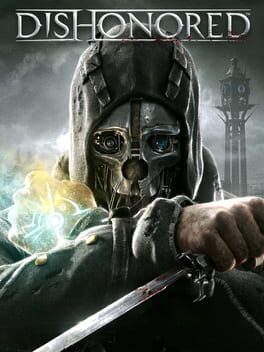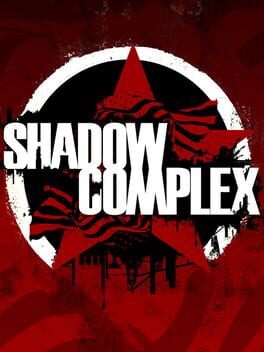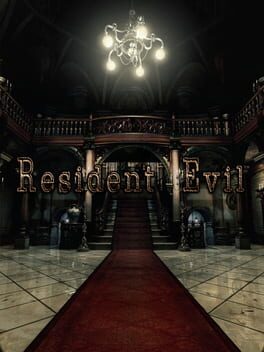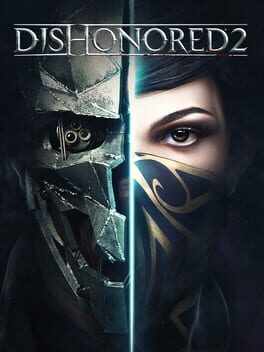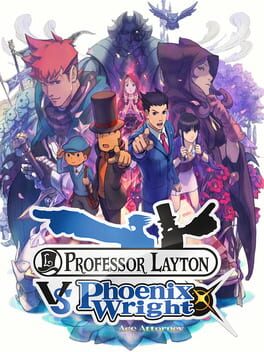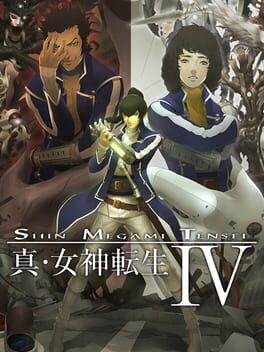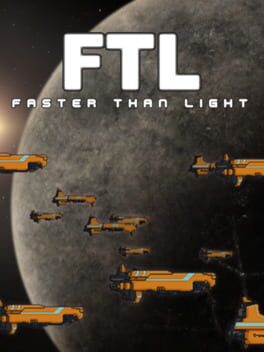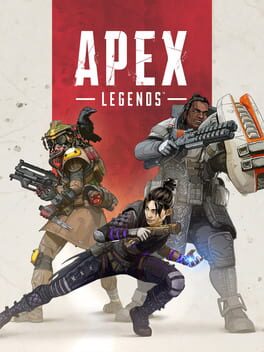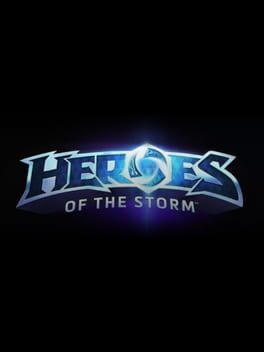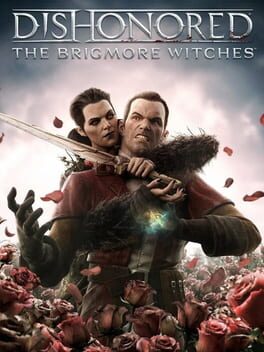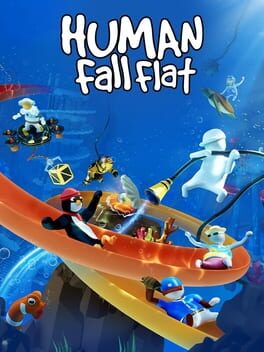synthezoid
2012
Arkane's breakout title is a rock-solid immersive sim with a few novel ideas but an overly simplistic view of how to integrate those to offer a myriad of solutions to problems. Coming off of Dark Messiah of Might and Magic, which is a stellar fantasy murder simulator but not an amazing stealth game, it's easy to see how aiming to make their own superpowered take on Thief could have gone awry. Perhaps they were still finding their footing, though, since this game's success turned out to be a sign of good things to come from Arkane. Still, Thief, Deus Ex, or even their own smashing success Prey this is not.
Instead, most problems have a straightforward handful of meaningfully different answers--still more than most games, but the limited selection of abilities and the painfully binary moral choices keep it from the creativity and emergent solutions offered by the best of the genre. The bone charms are a nice idea--mainly stat-based bonuses that reward you for exploring, in contrast to the whole new abilities runes unlock, but so few of them are actually interesting or useful that they don't always feel rewarding to hunt down, particularly when it turns out they have nothing to do with your playstyle. If, instead, they were currency to upgrade your stats (much like runes are for your powers) then they'd both be more flexible and more useful. (Alternately, the system used in the DLC and sequel works fine, where some of them are stronger with drawbacks.) If you're going for a nonlethal run, this will feel even more restrictive, since over half the abilities and charms will simply be non-options most of the time.
A few levels have just-out-of-reach ledges and rooftops blocked by invisible walls which should seemingly be accessible with your blink and enhanced jump, which is highly disappointing to come across in a game like this, though luckily not for very long, since the levels are otherwise full of alternate paths. Still, this combined with the incessant tutorials reminding you "hey, there's more than one way to approach this!" for the first three or four levels serves to make it feel more railroaded than it may actually be--like the developers already thought of and scripted in whatever approach you're taking rather than thinking of it yourself. I mean, of course they did, but I don't want to feel like it.
Still, highly effective level design and the plain fun of what IS there in its toolset, along with a striking art style that has aged better than most late-console-generation games of its time, help make it fun the whole way through, and the crisp pacing makes it brisk enough to play through to completion.
Instead, most problems have a straightforward handful of meaningfully different answers--still more than most games, but the limited selection of abilities and the painfully binary moral choices keep it from the creativity and emergent solutions offered by the best of the genre. The bone charms are a nice idea--mainly stat-based bonuses that reward you for exploring, in contrast to the whole new abilities runes unlock, but so few of them are actually interesting or useful that they don't always feel rewarding to hunt down, particularly when it turns out they have nothing to do with your playstyle. If, instead, they were currency to upgrade your stats (much like runes are for your powers) then they'd both be more flexible and more useful. (Alternately, the system used in the DLC and sequel works fine, where some of them are stronger with drawbacks.) If you're going for a nonlethal run, this will feel even more restrictive, since over half the abilities and charms will simply be non-options most of the time.
A few levels have just-out-of-reach ledges and rooftops blocked by invisible walls which should seemingly be accessible with your blink and enhanced jump, which is highly disappointing to come across in a game like this, though luckily not for very long, since the levels are otherwise full of alternate paths. Still, this combined with the incessant tutorials reminding you "hey, there's more than one way to approach this!" for the first three or four levels serves to make it feel more railroaded than it may actually be--like the developers already thought of and scripted in whatever approach you're taking rather than thinking of it yourself. I mean, of course they did, but I don't want to feel like it.
Still, highly effective level design and the plain fun of what IS there in its toolset, along with a striking art style that has aged better than most late-console-generation games of its time, help make it fun the whole way through, and the crisp pacing makes it brisk enough to play through to completion.
2009
A criminally underrated and underplayed Metroidvania with some of the coolest sequence-breaking tools around. The story and presentation are as 2009-Xbox-exclusive as it gets (and tied into an Orson Scott Card novel, of all things), but you'll forget about all of that once you start playing with the foam gun.
1998
2017
2014
This review contains spoilers
Incredible game. I will say, though, that it has a learning curve. If "normal mode" (the 'mountain climb' difficulty) had a bit more time to ease you into the mechanics of dodging, killing, and negotiating the mansion's zombies, it'd be perfect. As it is, I switched to the middle difficulty--which turned out to be easy mode--after some rough deaths on normal in the hopes of getting acclimated. By the end, though, I was overflowing on resources and the bosses were mostly trivial. If I could've had something in between the two difficulties, that might've been ideal, or something which started easier but ramped harder by the end.
Also, this is NOT a game you should stop playing in the hopes of picking it up weeks, months, or years later. There are too many interlocking puzzle pieces to keep track of for that to be anything less than annoying. However, this is the same reason it's so engaging to binge-play that it only took me a few sessions. If, however, there were some way to mark or write on the map (i.e. "shield lock here," "clock puzzle," "dogs!") that would be a non-issue (and would make the backtracking a bit less tedious if you have a small working memory).
I put those points first because other than that, it's damn near flawless. The puzzles are almost never too tough or obtuse, the combat is simple but works, and the scares are there in spades. It builds them up, too. It doesn't seem too bad at first once you learn how to handle a zombie, but it constantly throws something new at you and finds ways to twist the mansion against you. And it only goes up from there, saving some of the scariest enemies and most thrilling moments for the final act. The main downside is that the boss fights aren't too challenging or interesting--assuming you saved your most powerful ammo for them--but that's a necessary consequence of the clunkier control scheme than modern games. The more awkward combat mechanics mean that a boss can't require precise aiming or navigation, just some basic dodging and the occasional puzzle solving, but that's fine. It's for this reason that Plant 42 is one of the standouts--you only need to leave and solve a puzzle to beat it instead of spamming grenades at it. The character of the bosses goes a long way, at least: Yawn's jump scare for the second fight, Lisa Trevor's stalking, and Neptune's... sharkiness. Still, the climactic fights don't stand out the way RE2make or RE4's more action-driven battles do, even if they have just as much personality.
These scares are all served by its atmosphere, with compelling sound design that always seems to know how to manage music, ambience, and volume to great effect. But the standout here are the pre-rendered backgrounds, which have a beautiful yet ethereal quality to them that only serves to make the mansion feel more like a waking nightmare. They would be nothing, however, without the fixed camera angles which are aggressively cinematic--even more so than most games of this type. Only on rare occasions does this make you accidentally run into a zombie out of frame, but that's an entirely worthwhile sacrifice. Few other games commit so hard to the control of tone and information that the fixed camera provides, and none do it so well.
Narratively, it's no Silent Hill 2, but it balances its intense spooks with an absolute charmer of a silly B-movie script (with some genuinely effective plot threads sewn into the background through lore items scattered about the world).
Now let me entertain a theory. Resident Evil is basically the Evil Dead of video games: it starts out as a serious and deadly effective, yet campy, horror dream (Evil Dead 1=Resident Evil 1-3), but as the series progresses, it gets more self-aware, more campy, and more absurd before turning into outright action (Evil Dead 2/Army of Darkness=Resident Evil 4-6). Somewhere along the way, there's a serious but seriously overlooked attempt to call back to the series' roots that no one talks about anymore (Evil Dead 2013=Resident Evil Revelations). Eventually, years down the line, they return to form with a fan-pleaser that both moves the series forward and calls back to what everyone loved about it. (Ash vs. Evil Dead=Resident Evil 7).
Wait, what was I saying?
Oh, yeah.
Masterpiece.
Also, this is NOT a game you should stop playing in the hopes of picking it up weeks, months, or years later. There are too many interlocking puzzle pieces to keep track of for that to be anything less than annoying. However, this is the same reason it's so engaging to binge-play that it only took me a few sessions. If, however, there were some way to mark or write on the map (i.e. "shield lock here," "clock puzzle," "dogs!") that would be a non-issue (and would make the backtracking a bit less tedious if you have a small working memory).
I put those points first because other than that, it's damn near flawless. The puzzles are almost never too tough or obtuse, the combat is simple but works, and the scares are there in spades. It builds them up, too. It doesn't seem too bad at first once you learn how to handle a zombie, but it constantly throws something new at you and finds ways to twist the mansion against you. And it only goes up from there, saving some of the scariest enemies and most thrilling moments for the final act. The main downside is that the boss fights aren't too challenging or interesting--assuming you saved your most powerful ammo for them--but that's a necessary consequence of the clunkier control scheme than modern games. The more awkward combat mechanics mean that a boss can't require precise aiming or navigation, just some basic dodging and the occasional puzzle solving, but that's fine. It's for this reason that Plant 42 is one of the standouts--you only need to leave and solve a puzzle to beat it instead of spamming grenades at it. The character of the bosses goes a long way, at least: Yawn's jump scare for the second fight, Lisa Trevor's stalking, and Neptune's... sharkiness. Still, the climactic fights don't stand out the way RE2make or RE4's more action-driven battles do, even if they have just as much personality.
These scares are all served by its atmosphere, with compelling sound design that always seems to know how to manage music, ambience, and volume to great effect. But the standout here are the pre-rendered backgrounds, which have a beautiful yet ethereal quality to them that only serves to make the mansion feel more like a waking nightmare. They would be nothing, however, without the fixed camera angles which are aggressively cinematic--even more so than most games of this type. Only on rare occasions does this make you accidentally run into a zombie out of frame, but that's an entirely worthwhile sacrifice. Few other games commit so hard to the control of tone and information that the fixed camera provides, and none do it so well.
Narratively, it's no Silent Hill 2, but it balances its intense spooks with an absolute charmer of a silly B-movie script (with some genuinely effective plot threads sewn into the background through lore items scattered about the world).
Now let me entertain a theory. Resident Evil is basically the Evil Dead of video games: it starts out as a serious and deadly effective, yet campy, horror dream (Evil Dead 1=Resident Evil 1-3), but as the series progresses, it gets more self-aware, more campy, and more absurd before turning into outright action (Evil Dead 2/Army of Darkness=Resident Evil 4-6). Somewhere along the way, there's a serious but seriously overlooked attempt to call back to the series' roots that no one talks about anymore (Evil Dead 2013=Resident Evil Revelations). Eventually, years down the line, they return to form with a fan-pleaser that both moves the series forward and calls back to what everyone loved about it. (Ash vs. Evil Dead=Resident Evil 7).
Wait, what was I saying?
Oh, yeah.
Masterpiece.
2016
Everything Dishonored aspired to be, Dishonored 2 just is.
It's better than the first without ever losing sight of what made the first work. Possibly Arkane's finest game--though Prey is up there too--but it's not well-optimized. Still, the level design is some of the best I've ever seen, and it kept me playing through the occasional stuttering and frame drops.
Speaking of level design, wow. That's all I'll say about that. There are a couple levels that'll blow you away conceptually, and the rest will probably blow you away with how sophisticated and engrossing they are. I found myself excited to get lost and hunt down every trinket I could see in a way that the first game--and most games--often failed to make me. Wow.
Importantly, this game offers an even more exciting toolkit than before--two, in fact, since you can choose Emily or Corvo, both of whom have some exciting possibilities for any playstyle. It's a much less simplistic affair this time around if you're going for a nonlethal run (like I often try to), since the possible solutions are cranked up tenfold with all the different abilities on display, and the levels feel even more branching and liberating to compensate. Don't be fooled into thinking this means it'll be easy, though. I played on Hard and found it a tough but fair challenge (a marked step up from the equivalent difficulty in Dishonored 1), since the stronger and more varied tools at your disposal are constantly matched up against new and exciting puzzles, obstacles, and enemies each level. Dishonored 1 had a few too many invisible walls and a few too few solutions to a lot of problems to compete with the best immersive sims, leading to it either being so easy that it felt frictionless or, in rare moments, a bit frustrating. This game, however, ticks every box I want. I look forward to going back someday to play it a totally different way, which is perhaps the highest praise an immersive sim can get.
While many fans compare this game's story unfavorably to the first, personally it worked better for me--though neither of them got me too emotional, I found myself more invested in what would happen by the end of this one, even if it resorts to the same basic high/low chaos binary as before. The returning characters from the original game and its stellar DLC helped build attachments to some NPCs who didn't do as much the first time around.
All in all, it's Dishonored, but more, and better. It's Arkane at their best, and few do it like Arkane.
It's better than the first without ever losing sight of what made the first work. Possibly Arkane's finest game--though Prey is up there too--but it's not well-optimized. Still, the level design is some of the best I've ever seen, and it kept me playing through the occasional stuttering and frame drops.
Speaking of level design, wow. That's all I'll say about that. There are a couple levels that'll blow you away conceptually, and the rest will probably blow you away with how sophisticated and engrossing they are. I found myself excited to get lost and hunt down every trinket I could see in a way that the first game--and most games--often failed to make me. Wow.
Importantly, this game offers an even more exciting toolkit than before--two, in fact, since you can choose Emily or Corvo, both of whom have some exciting possibilities for any playstyle. It's a much less simplistic affair this time around if you're going for a nonlethal run (like I often try to), since the possible solutions are cranked up tenfold with all the different abilities on display, and the levels feel even more branching and liberating to compensate. Don't be fooled into thinking this means it'll be easy, though. I played on Hard and found it a tough but fair challenge (a marked step up from the equivalent difficulty in Dishonored 1), since the stronger and more varied tools at your disposal are constantly matched up against new and exciting puzzles, obstacles, and enemies each level. Dishonored 1 had a few too many invisible walls and a few too few solutions to a lot of problems to compete with the best immersive sims, leading to it either being so easy that it felt frictionless or, in rare moments, a bit frustrating. This game, however, ticks every box I want. I look forward to going back someday to play it a totally different way, which is perhaps the highest praise an immersive sim can get.
While many fans compare this game's story unfavorably to the first, personally it worked better for me--though neither of them got me too emotional, I found myself more invested in what would happen by the end of this one, even if it resorts to the same basic high/low chaos binary as before. The returning characters from the original game and its stellar DLC helped build attachments to some NPCs who didn't do as much the first time around.
All in all, it's Dishonored, but more, and better. It's Arkane at their best, and few do it like Arkane.
An engrossing cyber-fantasy-apocalypse narrative with buttery smooth turn-based gameplay, (SMT, as always, remains one of the most fun turn-based JRPGs out there), but I initially fucked up on getting the ending I actually wanted. This led to me just going for the Nihilist ending and dropping it for years. I did have an earlier save that was far enough back to secure the Neutral ending with some different choices, but I didn't feel like replaying those hours of content for a long time. When I finally committed to getting a proper ending, during boss fights or setpiece story moments, I was regularly reminded of how successful this game is at delivering both fun gameplay and powerful vibes (even if some of the characterizations get a bit cartoonish, undermining the plot's heavy moral themes; the very concept of "alignment reps" seems antithetical to making believable, fleshed-out, independently-motivated characters). The atmosphere of its decrepit, demonic world is sold almost entirely on its presentation. The character and monster designs look great, and the visual style of the world is appropriately gritty and mishmashed. But the real standout is its soundtrack, which punches so far above its weight class, it's hard to believe it came from some niche 3DS game that you can't even buy anymore.
Those mostly-good feelings were somewhat tarnished by how getting the Neutral ending nearly demands using a guide and feels like doing taxes. I managed with some trial and error and some foreknowledge about how alignment is tracked, but man. I kind of wish I had just committed to Law or Chaos instead, but the story just didn't give me enough to chew on with either to feel satisfied locking into them. On top of the Neutral ending being weirdly tough to unlock, it interrupts your momentum in the home stretch to make you to perform a bunch of repetitive sidequests. Adding insult to injury, the game offers no signposting as to which ones you actually need to do or where to get them (thanks Gamefaqs), so the pacing takes a nosedive here.
And speaking of signposting, navigating Tokyo without an eidetic memory is a slog. While most of the "dungeons" in this game, a Shin Megami Tensei mainstay, are drastically reduced in scale, complexity, and variety compared to earlier entries, the overworld itself feels like its own inescapable megadungeon. The map has essentially no labeling, and you can't move the camera to see regions of the map beyond the one you're in. There is a fast travel system, but it's a menu with no visual indication of where each terminal will spit you out, so it's only useful if you Google a map or have the geography of Tokyo memorized. Roads might look like they connect at a glance, but actually have indistinguishable grey rubble blocking the most convenient path. Buildings which connect regions of the overworld aren't always obvious. I don't always mind getting lost every now and then in a game, but the process of getting lost needs to be fun. SMT IV is not a Metroidvania, and its overworld design is nowhere near as distinctive, memorable, or well-designed as a good one. The aforementioned final stretch of the Neutral path, which involves substantial time spent running between previously-explored areas to perform menial labor, is made ten times more sluggish by this labyrinthine map combined with constant encounters against low level enemies. They're not a threat most of the time; it just takes far too long to fast-forward through inconsequential fights to not feel like padding. There is a demon ability which lets you one-shot lower-level fights without entering combat, but it requires a conscious effort to fuse or keep around a demon who has it, on top of manually applying it any time you need it. The inconvenience of this convenience feature counters much of the utility it might have, so I rarely bothered.
Or, if things do get tough again, you'll have to sit through an interminable dialogue with Charon just to get back to playing again. Every time you die. It's so long that, if you have a recent save and don't feel like spending Macca or 3DS Play Coins (yeah), it's faster to just close the game and relaunch it. I actually quite like that the game can be challenging (even if this mainly only applies near the beginning and end of the story). I like that boss fights encourage you to experiment to figure out their weaknesses and attack patterns (even if the press-turn and smirk systems punish this experimentation sometimes, making the optimal strategy involve testing a boss's weaknesses before you inevitably die and reload to actually take advantage of them). I love that you have to really understand and interact with the game's mechanics to get an edge, lest you be punished for stumbling into an enemy's resistances or end up unprepared to handle their debuffs. But it's absolutely mind-boggling that a game which needs you to be okay with dying periodically--or even repeatedly against the hardest enemies--makes something as basic as loading your last save take ages.
I am obsessed with player agency and getting to influence a narrative with my choices--so naturally, I love RPGs. Of course, JRPGs that do this are a rare treat. Still, SMT IV runs into an issue that I've seen in some other JRPGs with choice: it's just not as deep as I would like. The aforementioned multiple (non-Nihilist) endings, while a cool concept, ultimately boil down to a math problem--did you make more Law or Chaos choices, or did you hit the sweet spot for Neutral?--without much in the way of alternate quest resolution or branching paths. There is no causal link between any individual choice and the outcome you get at the end of the game, which makes the consequences of each different ending feel a bit disconnected and arbitrary. This isn't objectively horrible (there are plenty of completely linear games that still end up being great, and SMT IV is more liberating than that), so I won't judge the game for not meeting benchmarks it never aimed for. Still, I can't help but feel like an SMT game with CRPG narrative sensibilities would be the coolest game in the world. (Tangent: I played Pillars of Eternity 2 recently, and it would make for a great SMT game if it were set in apocalyptic Tokyo instead of fantasy-pirate-land--that game's themes, especially regarding the role of the divine in human governance, mirror SMT's law-neutral-chaos divide shockingly well.) Maybe SMT IV would be better if it were about half as long but twice as reactive to your choices. That would certainly alleviate most of my padding and pacing concerns.
All in all, SMT IV is a decidedly not-perfect greatest hits album of themes, demons, mechanics, and plot elements from previous mainline SMT games. The new stuff--like the soundtrack, visuals, quality-of-life adjustments, and main characters, are all great, but also feel like they could have shined more unshackled from the genre and formula expectations of a decades-old RPG franchise. Still, for me, it was a slick and strong introduction to what makes SMT tick. It might not be the best JRPG in the world, but it's certainly one of the coolest.
Those mostly-good feelings were somewhat tarnished by how getting the Neutral ending nearly demands using a guide and feels like doing taxes. I managed with some trial and error and some foreknowledge about how alignment is tracked, but man. I kind of wish I had just committed to Law or Chaos instead, but the story just didn't give me enough to chew on with either to feel satisfied locking into them. On top of the Neutral ending being weirdly tough to unlock, it interrupts your momentum in the home stretch to make you to perform a bunch of repetitive sidequests. Adding insult to injury, the game offers no signposting as to which ones you actually need to do or where to get them (thanks Gamefaqs), so the pacing takes a nosedive here.
And speaking of signposting, navigating Tokyo without an eidetic memory is a slog. While most of the "dungeons" in this game, a Shin Megami Tensei mainstay, are drastically reduced in scale, complexity, and variety compared to earlier entries, the overworld itself feels like its own inescapable megadungeon. The map has essentially no labeling, and you can't move the camera to see regions of the map beyond the one you're in. There is a fast travel system, but it's a menu with no visual indication of where each terminal will spit you out, so it's only useful if you Google a map or have the geography of Tokyo memorized. Roads might look like they connect at a glance, but actually have indistinguishable grey rubble blocking the most convenient path. Buildings which connect regions of the overworld aren't always obvious. I don't always mind getting lost every now and then in a game, but the process of getting lost needs to be fun. SMT IV is not a Metroidvania, and its overworld design is nowhere near as distinctive, memorable, or well-designed as a good one. The aforementioned final stretch of the Neutral path, which involves substantial time spent running between previously-explored areas to perform menial labor, is made ten times more sluggish by this labyrinthine map combined with constant encounters against low level enemies. They're not a threat most of the time; it just takes far too long to fast-forward through inconsequential fights to not feel like padding. There is a demon ability which lets you one-shot lower-level fights without entering combat, but it requires a conscious effort to fuse or keep around a demon who has it, on top of manually applying it any time you need it. The inconvenience of this convenience feature counters much of the utility it might have, so I rarely bothered.
Or, if things do get tough again, you'll have to sit through an interminable dialogue with Charon just to get back to playing again. Every time you die. It's so long that, if you have a recent save and don't feel like spending Macca or 3DS Play Coins (yeah), it's faster to just close the game and relaunch it. I actually quite like that the game can be challenging (even if this mainly only applies near the beginning and end of the story). I like that boss fights encourage you to experiment to figure out their weaknesses and attack patterns (even if the press-turn and smirk systems punish this experimentation sometimes, making the optimal strategy involve testing a boss's weaknesses before you inevitably die and reload to actually take advantage of them). I love that you have to really understand and interact with the game's mechanics to get an edge, lest you be punished for stumbling into an enemy's resistances or end up unprepared to handle their debuffs. But it's absolutely mind-boggling that a game which needs you to be okay with dying periodically--or even repeatedly against the hardest enemies--makes something as basic as loading your last save take ages.
I am obsessed with player agency and getting to influence a narrative with my choices--so naturally, I love RPGs. Of course, JRPGs that do this are a rare treat. Still, SMT IV runs into an issue that I've seen in some other JRPGs with choice: it's just not as deep as I would like. The aforementioned multiple (non-Nihilist) endings, while a cool concept, ultimately boil down to a math problem--did you make more Law or Chaos choices, or did you hit the sweet spot for Neutral?--without much in the way of alternate quest resolution or branching paths. There is no causal link between any individual choice and the outcome you get at the end of the game, which makes the consequences of each different ending feel a bit disconnected and arbitrary. This isn't objectively horrible (there are plenty of completely linear games that still end up being great, and SMT IV is more liberating than that), so I won't judge the game for not meeting benchmarks it never aimed for. Still, I can't help but feel like an SMT game with CRPG narrative sensibilities would be the coolest game in the world. (Tangent: I played Pillars of Eternity 2 recently, and it would make for a great SMT game if it were set in apocalyptic Tokyo instead of fantasy-pirate-land--that game's themes, especially regarding the role of the divine in human governance, mirror SMT's law-neutral-chaos divide shockingly well.) Maybe SMT IV would be better if it were about half as long but twice as reactive to your choices. That would certainly alleviate most of my padding and pacing concerns.
All in all, SMT IV is a decidedly not-perfect greatest hits album of themes, demons, mechanics, and plot elements from previous mainline SMT games. The new stuff--like the soundtrack, visuals, quality-of-life adjustments, and main characters, are all great, but also feel like they could have shined more unshackled from the genre and formula expectations of a decades-old RPG franchise. Still, for me, it was a slick and strong introduction to what makes SMT tick. It might not be the best JRPG in the world, but it's certainly one of the coolest.
Moody, tactical, challenging, intense, deep, addicting, punishing, rewarding, downright dopaminergic, and impossibly, unbelievably entrancing.
When I started playing FTL, I was too stubborn to try Easy mode; I appreciate a good, fair challenge. Countless runs and dozens of hours later, I beat the game for the first time on Normal and achieved what I can only describe as my greatest victory in a video game. Between the clean, minimal visuals, the astonishingly atmospheric soundtrack by Ben Prunty, and the alternately cruel and magical narrative arc the game procedurally puts you through every time, FTL is the most immersive spacefaring game I've ever played. I really do feel like I'm lost in a hostile galaxy every single time. So, when I clawed my first victory out of the wreckage of the Rebel flagship, it didn't just feel like I had beaten a video game. It felt like I had won a war.
When I started playing FTL, I was too stubborn to try Easy mode; I appreciate a good, fair challenge. Countless runs and dozens of hours later, I beat the game for the first time on Normal and achieved what I can only describe as my greatest victory in a video game. Between the clean, minimal visuals, the astonishingly atmospheric soundtrack by Ben Prunty, and the alternately cruel and magical narrative arc the game procedurally puts you through every time, FTL is the most immersive spacefaring game I've ever played. I really do feel like I'm lost in a hostile galaxy every single time. So, when I clawed my first victory out of the wreckage of the Rebel flagship, it didn't just feel like I had beaten a video game. It felt like I had won a war.
2019
The gunplay is some of the best I've seen in any battle royale, but I just don't have any motivation to continue playing once my friends drop it. At least PUBG, as much of a mess as that game is, was addicting for a while, solo or otherwise. Ultimately, it's one of the most mechanically solid battle royales, but with one of the most limited sets of game modes, and it still ultimately feels like a diversion from Titanfall 2's already incredible--and more mechanically rich--multiplayer.
2015
Throws away some of the most satisfying bits of other MOBAs (none of which I particularly love, admittedly) like last hitting, creep denial, and their greater depth, for the sake of also throwing out some of their unwelcoming complexity. In the process, it makes something more casual and accessible, but also a hell of a lot more bland. The use of different maps was a wonderful idea and drawing from Blizzard's iconic roster is great, but it's just not that fun, whereas even League can be a solid time with friends in the right moment.
2019
"Welcome to corporate America."
It's been a long time since I've found the motivation to replay a game's story mode--games are often long, life is often busy, and my backlog is growing faster than I can shrink it. But this game's second run system which turns your understanding of the game world inside out by sending you through it in a different way while telling a new (but connected) story within it tipped me over the edge. I beat it on my first run about a week prior, took some time off to beat Resident Evil 4 (a masterpiece in its own right), then came right back to this. I'm working through my second run, Claire's B campaign, on Hardcore mode this time, and it is intense, difficult, and even more terrifying than last time. I love it.
It takes all the strengths of classic Resident Evil, (the interconnected, puzzle-littered hallways of the police station will feel familiar to anyone who has braved Resident Evil 1 Remake's mansion--have you? It's also an incredible game!) but anything that might have even verged on tedious is cleaned up; the map marks rooms with things left to find and unsolved puzzles instead of asking you to memorize them, write them down or wander aimlessly. While the beautiful, cinematic fixed camera angles of that game will be missed, the crisp control of Leon and Claire's shooting and the increased action allowed in boss fights or more dramatic enemy encounters as a result of the over-the-shoulder camera feels like the full realization of what classic Resident Evil merely evoked with its more simplistic fights.
And the scares! It's not the most terrifying game ever made, but man is it tense. Mr. X has had volumes written about him, so I won't belabor the point, but he'll get his moments over you, as will many other enemies, sooner or later. I hope I never have to hear a set of loud footsteps approaching when I'm out at night. There's always just the right amount of ammo to make it possible to get around enemies but impossible to actually kill more than a few at a time. This combined with the ever evolving layout and paths around the station makes it an uneasy but immensely rewarding task to venture out of your save room.
This core gameplay loop of exploration, infrequent combat, and the occasional bombastic, brilliant, satisfying boss fight before the eventual return to peace makes it downright addicting for the ~8 hour length of your first campaign. It's tight and utterly devoid of chaff, and this is what makes the prospect of a second run with some changes so appealing--it's simultaneously satisfying and leaves you wanting more of it. That, to me, is the mark of a perfectly paced game, and the character switch takes such smart advantage of it that I wish more games focused on being concise, well-crafted, and replayable instead of big, big, big. The characters themselves are both easy to get attached to, too, and they each have their own arcs with a few unique supporting characters. Leon is immensely relatable, always seeming to say what I'm thinking, and Claire is both believable and likable as the unlikely hero of her story.
That's not to say it takes itself seriously all the time, of course. It's impossible for Resident Evil to totally shake off its B-movie charm, even with the insane production values of a game like this. The nine-foot-tall Mr. X dresses in a fedora and trench coat to blend in, for one. It could never avoid being hilarious. It's just that, like some of the best classic low-budget horror films (Evil Dead 1 comes to mind), this doesn't get in the way of its thrills, scares, or story. The gradual amping-up of the stakes and scope doesn't feel like a cheap or formulaic escalation, but a necessary and satisfying payoff. The narrative is just as gripping as any other part of the game, and every part of it gripped me tighter than an angry Tyrant. It's rare that a game comes out which is simultaneously so focused and so crowdpleasing, so tough and so well-designed, so highly-produced and still so passionately made. It's been so long since I loved a game quite this much, but then again, it's been a long time since I played a game quite this good.
It's been a long time since I've found the motivation to replay a game's story mode--games are often long, life is often busy, and my backlog is growing faster than I can shrink it. But this game's second run system which turns your understanding of the game world inside out by sending you through it in a different way while telling a new (but connected) story within it tipped me over the edge. I beat it on my first run about a week prior, took some time off to beat Resident Evil 4 (a masterpiece in its own right), then came right back to this. I'm working through my second run, Claire's B campaign, on Hardcore mode this time, and it is intense, difficult, and even more terrifying than last time. I love it.
It takes all the strengths of classic Resident Evil, (the interconnected, puzzle-littered hallways of the police station will feel familiar to anyone who has braved Resident Evil 1 Remake's mansion--have you? It's also an incredible game!) but anything that might have even verged on tedious is cleaned up; the map marks rooms with things left to find and unsolved puzzles instead of asking you to memorize them, write them down or wander aimlessly. While the beautiful, cinematic fixed camera angles of that game will be missed, the crisp control of Leon and Claire's shooting and the increased action allowed in boss fights or more dramatic enemy encounters as a result of the over-the-shoulder camera feels like the full realization of what classic Resident Evil merely evoked with its more simplistic fights.
And the scares! It's not the most terrifying game ever made, but man is it tense. Mr. X has had volumes written about him, so I won't belabor the point, but he'll get his moments over you, as will many other enemies, sooner or later. I hope I never have to hear a set of loud footsteps approaching when I'm out at night. There's always just the right amount of ammo to make it possible to get around enemies but impossible to actually kill more than a few at a time. This combined with the ever evolving layout and paths around the station makes it an uneasy but immensely rewarding task to venture out of your save room.
This core gameplay loop of exploration, infrequent combat, and the occasional bombastic, brilliant, satisfying boss fight before the eventual return to peace makes it downright addicting for the ~8 hour length of your first campaign. It's tight and utterly devoid of chaff, and this is what makes the prospect of a second run with some changes so appealing--it's simultaneously satisfying and leaves you wanting more of it. That, to me, is the mark of a perfectly paced game, and the character switch takes such smart advantage of it that I wish more games focused on being concise, well-crafted, and replayable instead of big, big, big. The characters themselves are both easy to get attached to, too, and they each have their own arcs with a few unique supporting characters. Leon is immensely relatable, always seeming to say what I'm thinking, and Claire is both believable and likable as the unlikely hero of her story.
That's not to say it takes itself seriously all the time, of course. It's impossible for Resident Evil to totally shake off its B-movie charm, even with the insane production values of a game like this. The nine-foot-tall Mr. X dresses in a fedora and trench coat to blend in, for one. It could never avoid being hilarious. It's just that, like some of the best classic low-budget horror films (Evil Dead 1 comes to mind), this doesn't get in the way of its thrills, scares, or story. The gradual amping-up of the stakes and scope doesn't feel like a cheap or formulaic escalation, but a necessary and satisfying payoff. The narrative is just as gripping as any other part of the game, and every part of it gripped me tighter than an angry Tyrant. It's rare that a game comes out which is simultaneously so focused and so crowdpleasing, so tough and so well-designed, so highly-produced and still so passionately made. It's been so long since I loved a game quite this much, but then again, it's been a long time since I played a game quite this good.
A rousing conclusion to Daud's DLC that includes a couple of my favorite missions in the game. It took time, but Arkane manages to up the ante with the DLC by improving and increasing the player's arsenal, particularly with a new selection of nonlethal options and a great set of levels in which to use them. Bone charms are also made much less boring by the inclusion of more powerful ones--with drawbacks, of course--that reward the player for specializing if they so choose. Maybe I'm imagining things, but I also felt like it relied less on objective markers holding the player's hand, particularly for side missions, which helps it feel more freeing than the base game, which often felt a bit too easy and frictionless--sure, you could explore and find some secrets, but you could just as often do some blinking to the next objective marker with minimal exploring and be on your merry way with little trouble, and as a result, little investment in the level, despite how well it may have been designed.
More toys, more tools, improvements to the ones already present, and levels at least on par with the main campaign make Daud's DLC a tighter and tauter experience that feels like what the main campaign could've been with a little more time in the oven. It also gets a hell of a lot of credit for doing (spoiler!) the impossible: making a boss fight work in an immersive sim. It's not super challenging, but it's a satisfying climax.
By forcing Daud to be the queen's assassin before the player ever gets control, then letting you choose how he develops, the high chaos and low chaos routes both add interesting stakes in the form of a tangible character arc. It's still shaped by your choices, but it lends weight to Daud's redemption or descent no matter how the player chooses to play, which is frankly brilliant.
More toys, more tools, improvements to the ones already present, and levels at least on par with the main campaign make Daud's DLC a tighter and tauter experience that feels like what the main campaign could've been with a little more time in the oven. It also gets a hell of a lot of credit for doing (spoiler!) the impossible: making a boss fight work in an immersive sim. It's not super challenging, but it's a satisfying climax.
By forcing Daud to be the queen's assassin before the player ever gets control, then letting you choose how he develops, the high chaos and low chaos routes both add interesting stakes in the form of a tangible character arc. It's still shaped by your choices, but it lends weight to Daud's redemption or descent no matter how the player chooses to play, which is frankly brilliant.
2016
